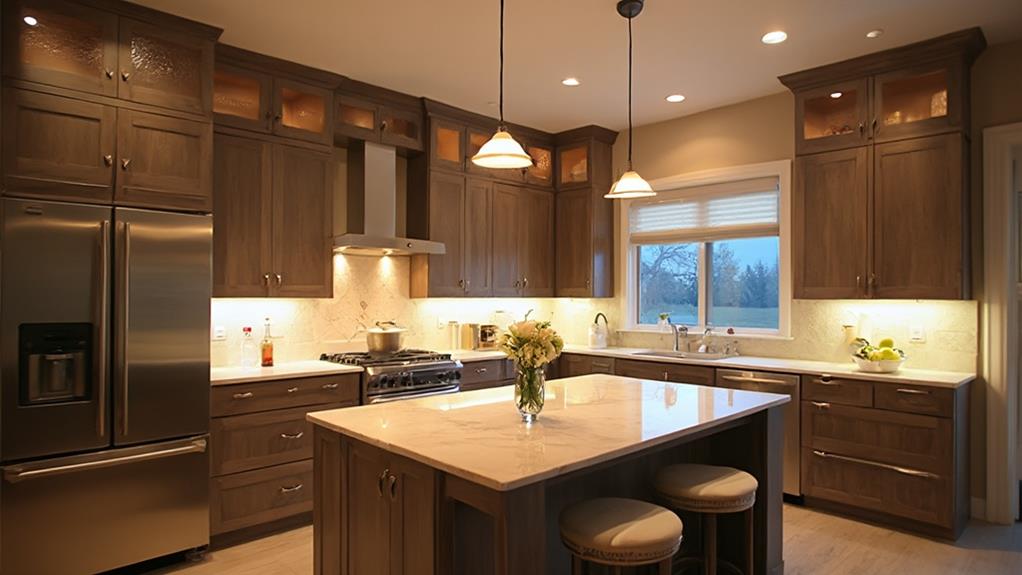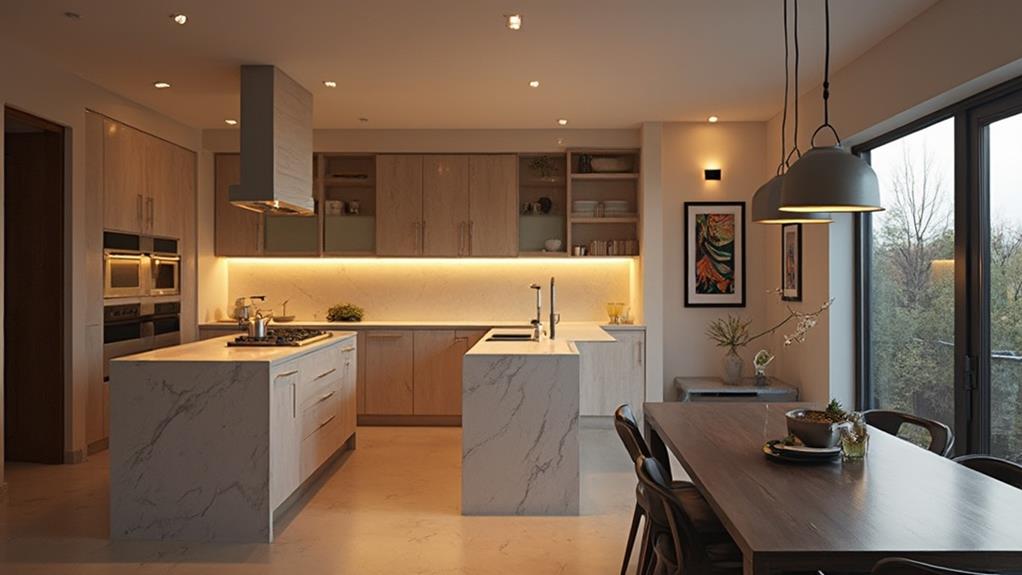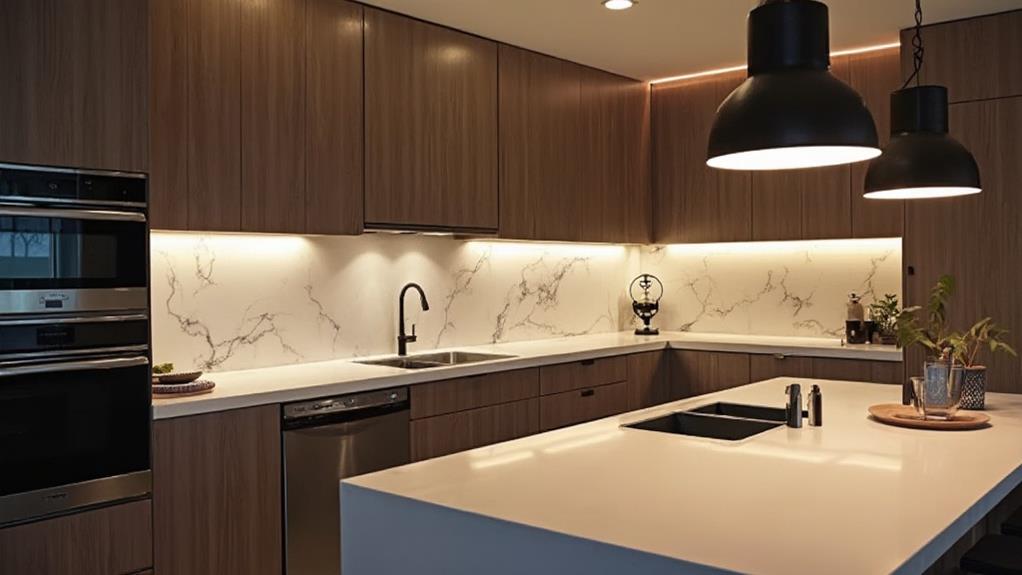Transform your kitchen from merely functional to truly fabulous with smart lighting design. Start by installing task lighting for work areas, like under-cabinet LEDs and pendant lights over islands. Add ambient lighting with recessed ceiling fixtures and natural light sources to create a warm atmosphere. Incorporate accent lighting to highlight architectural features and add visual interest. Layer these light sources and control them independently for maximum flexibility. Consider smart lighting solutions for convenience and energy efficiency. By mastering the art of layered lighting, you'll create a kitchen that's not only practical but also inviting and stylish. Discover how to illuminate your way to kitchen perfection.
Task Lighting Essentials

Illuminate your workspace with purpose. Task lighting in your kitchen is crucial for safely and efficiently preparing meals. Focus on three key areas: countertops, stovetop, and sink.
For countertops, install under-cabinet LED strips or puck lights to eliminate shadows and provide even illumination. These fixtures should be placed toward the front of the cabinets to avoid glare on the work surface.
For your stovetop, consider a range hood with built-in lighting or install recessed lights directly above. This ensures you can clearly see what you're cooking and monitor food as it simmers.
At the sink, pendant lights or recessed fixtures work well. Position them slightly in front of you to avoid casting shadows on your tasks.
Don't forget about pantry and cabinet interiors. Motion-activated LED strips can make finding ingredients a breeze. When selecting bulbs, opt for cool white or daylight temperatures (3000-5000K) for task areas. These provide crisp, clear light that enhances visibility and reduces eye strain. Dimmer switches allow you to adjust light levels for different times of day or tasks.
Ambient Lighting for Atmosphere
Once you've addressed task lighting, it's time to focus on ambient lighting to set the mood in your kitchen. Ambient lighting creates a warm, inviting atmosphere and provides overall illumination for the space. Consider using dimmer switches on your main light fixtures to adjust the brightness according to different times of day or occasions.
Recessed ceiling lights are an excellent choice for ambient lighting, offering even coverage without protruding into the room. Install them in a grid pattern for uniform illumination. Pendant lights over an island or dining area can serve as both task and ambient lighting, adding style and warmth to your kitchen.
For a softer glow, incorporate LED strip lights under cabinets or along the kickplate of your kitchen island. These subtle light sources create depth and dimension in the room. Wall sconces can also contribute to ambient lighting while adding visual interest to your kitchen's design.
Don't forget about natural light. If possible, maximize window space or add a skylight to flood your kitchen with daylight. Use light-colored window treatments to control the amount of natural light entering the space, allowing you to adjust the ambiance throughout the day.
Accent Lighting Techniques

With ambient lighting in place, it's time to highlight your kitchen's best features through accent lighting. Accent lighting draws attention to specific areas or objects, creating visual interest and depth. You'll want to focus on architectural details, artwork, or prized possessions.
Consider using recessed adjustable spotlights to illuminate open shelving or display cabinets. These fixtures can be angled to showcase your favorite dishes or decorative items. For a dramatic effect, install strip lights under floating shelves or along the toe kicks of lower cabinets.
Pendant lights over a kitchen island or breakfast bar serve as both functional task lighting and eye-catching accents. Choose fixtures that complement your kitchen's style and hang them at the appropriate height for optimal illumination.
Don't forget about your backsplash. LED tape lights installed under upper cabinets can wash your backsplash with a soft glow, highlighting its texture and color. For a subtle touch, use small puck lights inside glass-front cabinets to create a warm, inviting ambiance.
Remember to use dimmers with your accent lighting to adjust the intensity and mood as needed. This flexibility allows you to create the perfect atmosphere for any occasion, from intimate dinners to lively gatherings.
Layering Light Sources
Combining different types of lighting creates a well-balanced and functional kitchen space. To achieve this, you'll want to layer your light sources. Start with ambient lighting, which provides overall illumination. This can include recessed ceiling lights, flush-mount fixtures, or even natural light from windows.
Next, add task lighting to illuminate specific work areas. Under-cabinet lights, pendant lights over islands, and adjustable track lighting are excellent options for food prep zones and cooking surfaces. Don't forget about the sink area, where a well-placed sconce or recessed light can make dishwashing easier.
Finally, incorporate accent lighting to highlight architectural features, artwork, or display areas. LED strips inside glass-front cabinets, puck lights in open shelving, or a picture light above a favorite piece of art can add depth and interest to your kitchen.
Remember to use different switches or a smart lighting system to control each layer independently. This allows you to adjust the mood and functionality of your kitchen throughout the day. By carefully layering your light sources, you'll create a kitchen that's not only well-lit but also visually appealing and adaptable to various tasks and occasions.
Smart Lighting Solutions

Smart lighting solutions take kitchen illumination to the next level. These advanced systems allow you to control your kitchen's ambiance with ease, offering convenience and energy efficiency. With smart bulbs and fixtures, you can adjust brightness, color temperature, and even hue to suit your needs throughout the day.
Voice-activated assistants like Amazon Alexa or Google Home can integrate seamlessly with your smart lighting setup. You'll be able to turn lights on or off, dim them, or change their color using simple voice commands. This hands-free control is particularly useful when you're cooking or have messy hands.
Smart lighting apps let you create custom scenes for different activities. Set a bright, cool light for food prep, then switch to a warm, dimmed ambiance for dining. You can also program schedules to automate your lighting based on your daily routine or to simulate occupancy when you're away.
Motion sensors can be incorporated into your smart lighting system, automatically illuminating work areas as you move around the kitchen. This feature isn't only convenient but also helps conserve energy by ensuring lights are only on when needed.
Conclusion
You've now got the tools to transform your kitchen lighting from merely functional to truly fabulous. By combining task, ambient, and accent lighting, you'll create a layered look that's both practical and stylish. Don't forget to explore smart lighting options for added convenience. Did you know that proper kitchen lighting can increase your home's value by up to 3%? So go ahead, brighten up your culinary space and watch its appeal soar.

